Spyro: Season of Ice - Smaller, Shoddier, But Just as Charming
30/06/25
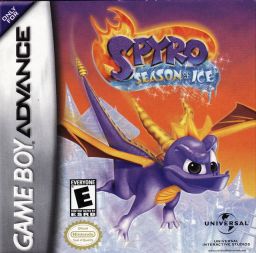
In the realm of the Playstation 1, there were no mascots on the level of Spyro the Dragon and Crash Bandicoot. After their respective classic trilogies, both series, now owned by Universal Interactive,followed notably parallel paths; both series received PS2 follow-ups that were considered generally worse than their iconic PS1 entries. But of more interest to us is the additional side-stories that emerged on the Game Boy Advance. Both series received several games that were understandably of a smaller scale and overall lower quality, whilst maintaining the heart and soul of their parent franchises. There were also some really, really bad crossovers between the two, but the less said, the better - and we’ll get there, eventually, as we always do. Either way, these franchises flourished in the smaller environment of the GBA. Crash’s duology is a perfect, almost bite-sized simulacrum of the core Crash experience, and I’m glad to say, on a fundamental level, Spyro: Season of Ice equally managed to carry the gorgeous, 3D collectathon experience of the Spyro the Dragon trilogy into a portable, isometric format. But whilst Crash managed to scrape by with only scratches and bruises to weaken the overall experience, Digital Eclipse's rendition of the little purple dragon’s adventure suffers from more intrinsic structural issues.
The core Spyro trilogy that has become so iconic over the years is one that I didn’t really touch until I was a young adult. At most, I played the hell out of the second game, Spyro: Gateway to Glimmer (known elsewhere as Ripto’s Rage), but my time was more spent in the Crash Bandicoot mines, or more topically, the very different but-still-very-good Spyro: A Hero’s Tail. But when I started playing Spyro: Season of Ice for the Game Boy Abyss’s 90th review, a memory bloomed in my mind - I *owned* this game. I played a bunch of, maybe as one of the very first games I ever owned on my childhood GBA. I can only remember scant fragments of playing one of many levels, and I must’ve lost it early in my GBA’s life because of how little I remember, but it was generally exciting to play through this and have little memories of my childhood with it pop up. I do wish I had the temperament of a child playing this, though, because oh man there are some rough edges that hurt as an older, more seasoned player that drove me up the wall.
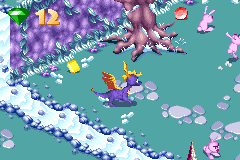
Whilst there were a handful of actual 3D platformer-esque titles on the Game Boy Advance, the vast majority of them were significantly kneecapped by the amount of power needed to facilitate such visuals. Much like Crash Bandicoot reverting to a 2D, sidescrolling format, Spyro: Season of Ice turns Spyro’s beautiful 3D locales into equally charming, cozy-looking isometric levels. It is, at its heart, the same kind of game as the original PS1 trilogy; Spyro has to go into a wide variety of worlds, hunting down a certain collectible - in this case, frozen faeries - to progress though the game, collecting gems to unlock new levels, and completing tasks for the denizens of each world which reward you with the acquisition of another fairy. Now, there are some fairly glaring issues with Digital Eclipse's edition of Spyro, but I think it’s important to state that fundamentally, they’ve done a great job of shrinking Spyro into a handheld format without drastically overhauling the kind of game it is. It’s still a level-based collectathon, with the game encouraging you to scrape through every level for just about everything you find. It’s just… more Spyro, just smaller and simpler, and as someone who really appreciates the art of the ‘demake’, I think they’ve done great work shrinking our already little purple dragon down.
Spyro’s basic moveset is fairly similar to that of his Playstation 1 rendition; he can still charge ahead, glide with a hover at the end, and let loose a burst of flame to break items and take out foes in equal measure. He doesn’t quite have all the additional bells and whistles that popped up in the PS1 trilogy, namely the special breath abilities he’d occasionally wield or horn slams , but with the simpler, more rigid structure of Season of Ice this didn’t particularly bother me. He generally controls pretty well, if a bit twitchy and a little loose when you’re trying to do some slightly more precise platforming. The game’s overall structure follows that of the original trilogy; Spyro travels through a number of hub worlds, each of which feature a number of normal levels, along with an autoscrolling shooter segment, and a minigame mode where you play as Sparx, Spyro’s dragonfly buddy. Honestly, it feels the most like the original Spyro, but instead of rescuing frozen dragons, you’re just rescuing faeries. It’s a classic setup for a demake-esque experience, and this structure works perfectly for Spyro: Season of Ice.
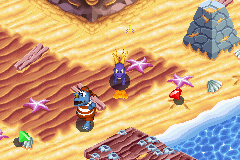
Now, for the most part playing through the levels of Season of Ice is a decently breezy experience - at first. Typically, there are around six faeries to rescue in each main level, with around half of them just hidden throughout the level, with a fourth usually requiring you to defeat all the enemies in the zone. Finally, you’ll usually have a bespoke objective to complete for each level - for example, ringing bells in a certain order in a temple-inspired zone, or plugging honeycombs in a bee-themed one - for a fifth faerie, with the final one obtained by burning all of a certain flammable object in each level. It’s a very rigid structure, overall, and it can feel a bit repetitive after a couple of hours with the game and you realise you’re essentially doing the same things again and again for the most part with just a new coat of paint and aesthetic each time. Now, I don’t want to make it out that this is some terrible oversight - the core gameplay of Season of Ice, running around and collecting everything that isn’t trying to kill you is great! I love collectathons, and Season of Ice scratches the itch in a way that almost no games on the GBA manage to do, but it’s a game that sort of peaks early in that sense. After you’ve completed the first hub area of stages, you’ve essentially seen everything the game has to offer. I certainly enjoyed it enough to push my way to the game’s end, but I can’t help but wish these levels had a bit more of a bespoke nature to them, rather than feeling a little bit like palette swaps in overall ‘mission’ design.
This frustration with the repetitiveness intensified when I began to try and 100% the game - which, as you’ll find at the end of the game, is a requirement to see the ending. As a massive fan of collectathons like this, this really rubbed me the wrong way; I don’t see an issue with having to complete 80-90% of a game’s collectibles to hit credits, but there needs to be a bit of wriggle room. No matter what kind of game it is, be it Jak and Daxter or Super Mario 64, there’ll always be specific tasks and collectibles people will specifically struggle with, something having a surplus of collectibles really helps with. Anyway, y’see, when you die in a level (unless you fully run out of lives), certain elements are saved; you’ll keep the progress of any faeries and gems you’ve collected, along with any foes defeated. However, when it comes to the side objectives present in every normal level - burning the ‘flammable object’ of the day and the key to the safe that holds a treasure trove of gems, these will reset upon death, requiring you to hunt down each and every one of them again. Now, the levels in Season of Ice are small enough that this isn’t inherently an awful task, but there is a certain fundamental issue with Spyro’s first foray onto the GBA that makes this a much more annoying act then it’d otherwise be. Y’see, Season of Ice isn’t particularly difficult - it’s just instead of being difficult, it opts, not by choice, to be *frustrating*.
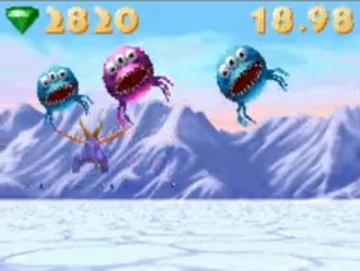
Because if there’s a single issue that really blights the overall quality of Season of Ice, is the lack of depth and height perception caused by both the isometric design of the game and the overall flat lighting of the game’s art direction. Whilst some levels are all connected by bridges and whatnot, the majority of levels are designed as a number of floating ‘islands’ above an abyss. These latter levels almost uniformly were more frustrating to complete, because you’ll see a nearby ‘island’ full of gems and whatnot, you’ll glide over to it… and plummet to your death as you realise its ‘floor’ was actually far, far higher than you realise. It sucks, because overall I really, really like the format of Spyro in an isometric setting, it really did feel like a true-blue Spyro game on the go, but they really should’ve tweaked the level design just a little bit to help facilitate knowing whether you can actually make it to the next platform. In fact, one or two levels do, in fact, do this - the Honey Marsh stage had a colour palette where higher ‘tiers’ of the islands were a slightly different colour to the lower ‘tiers’, so if I saw a very yellow mound, I knew not to fly that way unless I was 100% sure I’d make it. If they’d applied these visual designs to the other levels of this kind, I think I’d look back on this game a bit more fondly.
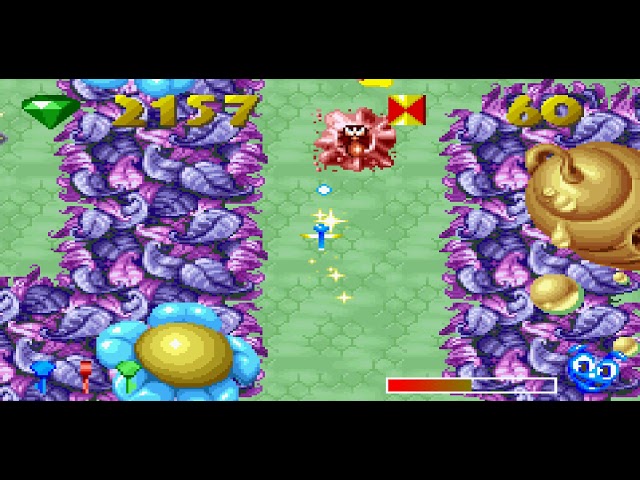
The game does somewhat break up the normal levels with a few additional gametypes. This game’s analogue to the Speedway levels from the original trilogy - time-based stages where Spyro had to destroy certain items and move through a number of checkpoints - is a timed autoscroller equivalent akin to something like an old arcade game like 1943. Flying through hoops, destroying projectiles, enemies and other dangers will keep your time up, with the goal being to make it to the end and destroy the boss. These levels aren’t anything special, but they’re different and engaging enough to work as a quick diversion between the more samey levels of the game. The other major side-format is one where you take the role of Sparx, Spyro’s dragonfly companion slash healthbar. These almost feel like a twinstick shooter, where Spark explores shrunk-down environments like forest floors or cave crevices, battling mini-monsters like ant swarms or moths with his… energy bolts? I dunno, but Sparx can really put out some firepower. These levels also, as it so happens, to be pretty awful. Sparx feels terrible to control, having a really weird-feeling sense of movement, and most of the bugs he’s blasting are miniscule and just dodge everything. Bosses, to make matters worse, are gigantic damage sponges, taking seemingly hundreds of shots to bring down, and they’re hit boxes are big enough that just avoiding them can be a task on their own. Thankfully there’s only four of these levels in the game, but I can’t stand these stages overall.
I know I’ve made reference to the game being like a demake, but Spyro really does feel like what you’d imagine if you pictured what Spyro would look like on a handheld console. The spritework is genuinely immaculate, with pretty much everything having this very cozy, laid-back vibe. Honestly, and this ties into the game’s issue with readability in regards to height and depth perception, the only major issues I have with Season of Ice’s visuals is how zoomed in and claustrophobic the game can feel at times. Honestly, I’d be a whole lot less annoyed with having to redo the parts of levels that reset upon death if I had a better idea of how to navigate these levels. The levels look great, with some fantastic theming, but the ‘blocks’ that make up each level can all blend together which makes it difficult for navigation. The music also feels perfect for Spyro’s first GBA foray - it doesn’t quite have the variety to match up to the PS1, with a bunch of songs sounding kind of samey. It’s got that wonderfully low-key, adventuring feeling, a genuine sense of exploration invoked by its bit-crunched tunes. Honestly, it’s surprisingly a lot more relaxing than I’d expected.
Spyro: Season of Ice has quite a few fundamental teething issues for his first foray on the Game Boy Advance; namely, the generally repetitive nature of the game, coupled with somewhat frustrating level design and issues with depth perception for it’s platforming. But the core of the game remains strong; it’s a perfect, pure distillation of Spyro’s original trilogy, with a satisfying collectathon to sink your teeth into, even if it sometimes expects a touch too much from its players. It’s not nearly on the level of its predecessors, but for his first time on a truly portable console? Season of Ice is perfectly satisfactory for those looking for something, anything like that original trilogy. Either way, it’s not like Enter the Dragonfly was doing much to uphold Spyro’s standard of quality.
Thanks for reading my review of Spyro: Season of Ice on the Game Boy Abyss! Man, ninety reviews. Can’t believe we’ve both made it this far, and that we’re this close to a hundred reviews. Nothing else to really say; thanks for reading this far. I’ll see you next week, have a good one.
